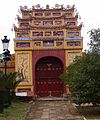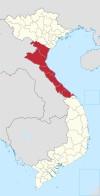Huế: Difference between revisions
| Line 247: | Line 247: | ||
*[http://english.thuathienhue.gov.vn/ Thua Thien Hue Province official website] |
*[http://english.thuathienhue.gov.vn/ Thua Thien Hue Province official website] |
||
*[http://www.huefestival.com/index_thongtin_e.htm Festival Huế] |
*[http://www.huefestival.com/index_thongtin_e.htm Festival Huế] |
||
*[http://asiain90days.blogspot.com/2010/11/hue-and-its-forbidden-city.html Photoblog of Huế and environs] |
|||
{{Coord|16|28|N|107|36|E|region:VN_type:city|display=title}} |
{{Coord|16|28|N|107|36|E|region:VN_type:city|display=title}} |
||
Revision as of 09:31, 30 November 2010
Huế | |
|---|---|
 | |
| Country | |
| Province | Thua Thien-Hue Province |
| Population ([citation needed]) | |
| • Total | 340,000 |
(化 in chữ Nôm) is the capital city of Thừa Thiên - Huế province, Vietnam. Between 1802 and 1945, it was the imperial capital of the Nguyễn Dynasty. It is well known for its monuments and architecture. Its population stands at about 340,000 people.
History
Huế originally rose to prominence as the capital of the Nguyễn Lords, a feudal dynasty which dominated much of southern Vietnam from the 17th to the 19th century. In 1775 when Trịnh Sâm captured it, it was known as Phú Xuân. In 1802, Nguyễn Phúc Ánh (later Emperor Gia Long) succeeded in establishing his control over the whole of Vietnam, thereby making Huế the national capital.[1]
Huế was the national capital until 1945, when Emperor Bảo Đại abdicated and a communist government was established in Hà Nội (Hanoi), in the north.[2] While Bảo Đại was briefly proclaimed "Head of State" with the help of the returning French colonialists in 1949 (although not with recognition from the communists and the full acceptance of the Vietnamese people), his new capital was Sài Gòn (Saigon), in the south.[3]
In the Vietnam War, Huế’s central position placed it very near the border between North Vietnam and South Vietnam; however, the city was located in South Vietnam. In the Tết Offensive of 1968, during the Battle of Huế, the city suffered considerable damage not only to its physical features, but its reputation as well, most of it from American firepower and bombings on the historical buildings as well as the massacre at Huế committed by the communist forces. After the war’s conclusion, many of the historic features of Huế were neglected because they were seen by the victorious regime and some other Vietnamese as "relics from the feudal regime"; the Vietnamese Communist Party doctrine officially described the Nguyễn Dynasty as "feudal" and "reactionary." There has since been a change of policy, however, and many historical areas of the city are currently being restored.
Geography and climate
The city is located in central Vietnam on the banks of the Sông Hương (Perfume River), just a few miles inland from the Biển Đông. It is about 700 km (438 mi.) south of the national capital of Hanoi and about 1100 km (690 mi.) north of Hồ Chí Minh City, the country’s largest city, formerly known as Saigon.
The climate is hot and generally wet (Köppen Af). Because of the angle of the central coast of Vietnam to the prevailing winds, however, Huế, like Chennai in India, receives most of its rainfall during the northeast monsoon between October and December. It is driest around March and April, but rain may still fall. The average annual rainfall of 3,000 millimetres (120 in) makes Huế one of the very wettest of Asian cities.[4]
| Huế | ||||||||||||||||||||||||||||||||||||||||||||||||||||||||||||
|---|---|---|---|---|---|---|---|---|---|---|---|---|---|---|---|---|---|---|---|---|---|---|---|---|---|---|---|---|---|---|---|---|---|---|---|---|---|---|---|---|---|---|---|---|---|---|---|---|---|---|---|---|---|---|---|---|---|---|---|---|
| Climate chart (explanation) | ||||||||||||||||||||||||||||||||||||||||||||||||||||||||||||
| ||||||||||||||||||||||||||||||||||||||||||||||||||||||||||||
| ||||||||||||||||||||||||||||||||||||||||||||||||||||||||||||
Religion
Hue takes Buddhism a bit more seriously here than most of Vietnam -- with more monasteries than anywhere else, and the nation's most famous monks. Famously in 1963, Thich Quang Duc drove to Saigon to protest anti-Buddhist policies of the South Vietnamese government and set himself on fire on a Saigon street. [5]
Historic monuments

Huế is well known for its historic monuments, which have earned it a place in UNESCO’s World Heritage Sites.[6] The seat of the Nguyễn emperors was the Citadel, which occupies a large, walled area on the north side of the Perfume River. Inside the citadel was a forbidden city where only the emperors, concubines, and those close enough to them were granted access; the punishment for trespassing was death. Today, little of the forbidden city remains, though reconstruction efforts are in progress to maintain it as a historic tourist attraction.
Roughly along the Perfume River from Huế lie myriad other monuments, including the tombs of several emperors, including Minh Mạng, Khải Định, and Tự Đức. Also notable is the Thiên Mụ Pagoda, the largest pagoda in Huế and the official symbol of the city.[7]
A number of French-style buildings lie along the south bank of the Perfume River. Among them are Quốc Học High School, the oldest high school in Vietnam, and Hai Ba Trung High School.
The Hue Museum of Royal Fine Arts on 3 Le Truc Street also maintains a collection of various artifacts from the city.
Administrative divisions
| UNESCO World Heritage Site | |
|---|---|
 | |
| Criteria | Cultural: iv |
| Reference | 678 |
| Inscription | 1993 (17th Session) |
Huế comprises 27 administrative divisions, including 27 phường (urban wards)
Urban wards
Cuisine
The cuisine of Huế draws from throughout Vietnam, but one of the most striking differences is the prominence of vegetarianism in the city. Several all-vegetarian restaurants are scattered in various corners of the city to serve the locals who have a strong tradition of eating vegetarian twice a month, as part of their Buddhist beliefs. Another feature of Huế dishes that sets them apart from other regional cuisines in Vietnam is the relatively small serving size with refined presentation, a vestige of its royal cuisine. Finally, another feature of Huế cuisine is that it is often very spicy.[8]
Pictures
-
Thế Miếu temple
-
Hiển Lâm
-
Thai Hoa Palace from the Courtyard of Audience
-
Emperor's throne, Thai Hoa Palace
-
The Nine Dynastic Urns in front of the Thế Miếu (Temple of Generations)
-
Hiển Nhân gate
-
Right bank of Hương river
-
Right bank of Hương river
-
Hương river by night
-
Trần Hưng Đạo street
-
Huong river
-
Thien Mu pagoda
-
Khải Định tomb
-
Từ Hiếu pagoda
-
Chùa Thiên Mụ
-
Bo tàng mỹ thuật cung đình Huế (Điện Long An)
See also
References
- ^ Woodside, Alexander (1988). Vietnam and the Chinese model: a comparative study of Vietnamese and Chinese government in the first half of the nineteenth century. Harvard Univ Asia Center. p. 127. ISBN 978-0674937215.
- ^ Boobbyer, Claire; Spooner, Andrew; O'Tailan, Jock (2008). Vietnam, Cambodia & Laos. Footprint Travel Guides. p. 122. ISBN 978-1906098094.
- ^ Stearns, Peter N.; Langer, William Leonard (2001). The Encyclopedia of world history: ancient, medieval, and modern, chronologically arranged. Houghton Mifflin Harcourt. p. 1036.
- ^ Ishizawa, Yoshiaki; Kōno, Yasushi; Rojpojchanarat, Vira; Daigaku, Jōchi; Kenkyūjo, Ajia Bunka (1988). Study on Sukhothai: research report. Institute of Asian Cultures, Sophia University. p. 68.
- ^ http://www.gonomad.com/market/0711/hue-food.html.
- ^ Along the world heritage path: Hue. Thanh Nien News. December 12, 2005.
- ^ Pham, Sherrise; Emmons, Ron; Eveland, Jennifer; Lin-Liu, Jen (2009). Frommer's Southeast Asia. Frommer's. p. 318. ISBN 978-0470447215.
- ^ Ngoc, Huu; Borton, Lady (2006). Am Thuc Xu Hue: Hue Cuisine. Vietnam.
External links
- Articles needing cleanup from November 2009
- Cleanup tagged articles without a reason field from November 2009
- Wikipedia pages needing cleanup from November 2009
- Huế
- Provincial capitals in Vietnam
- Populated places in Thua Thien-Hue Province
- District capitals in Vietnam
- World Heritage Sites in Vietnam
- Alliance for Healthy Cities
- Cities in Vietnam











